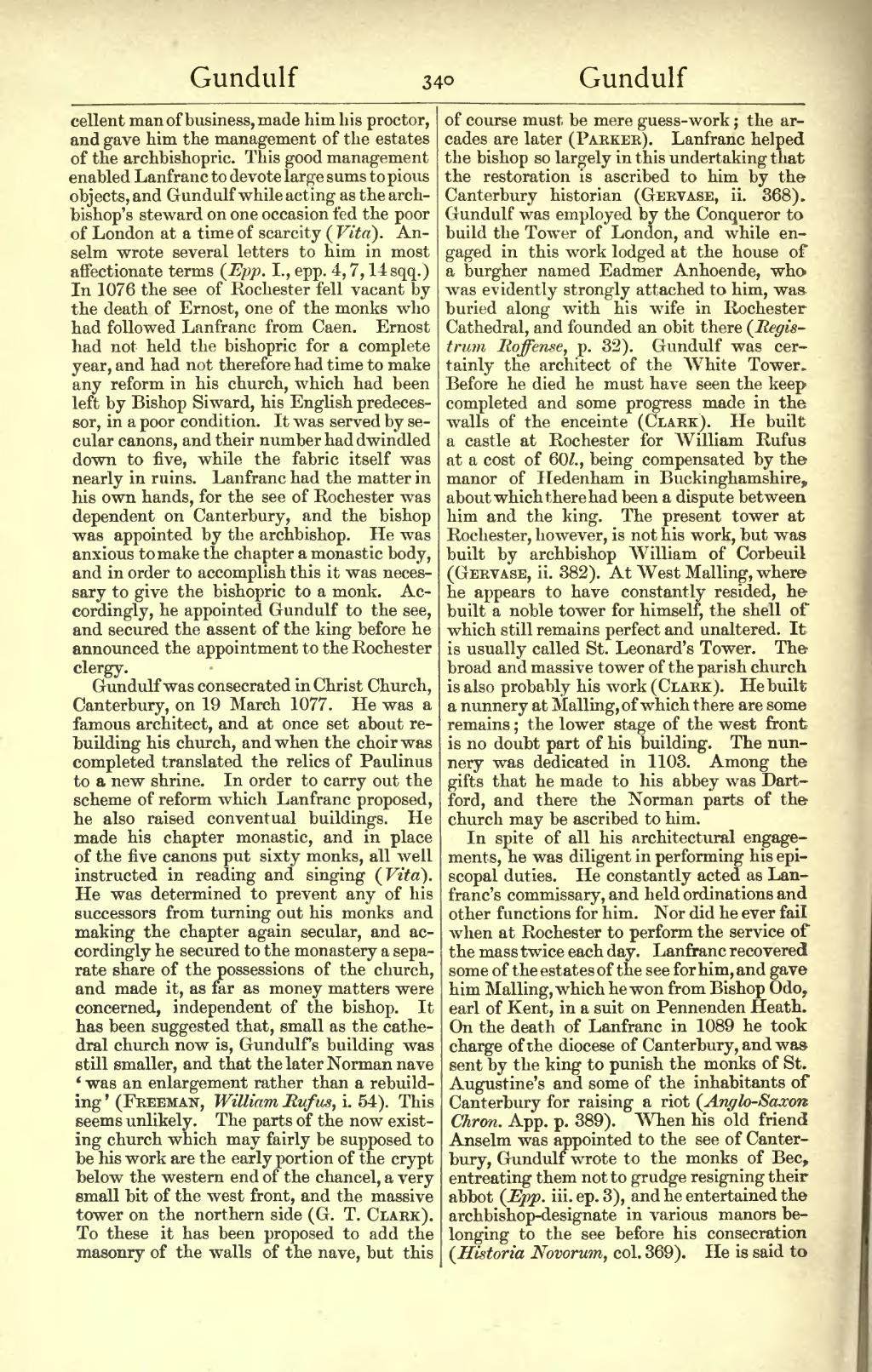cellent man of business, made him his proctor, and gave him the management of the estates of the archbishopric. This good management enabled Lanfranc to devote large sums to pious objects, and Gundulf while acting as the archbishop's steward on one occasion fed the poor of London at a time of scarcity (Vita). Anselm wrote several letters to him in most affectionate terms (Epp. I., epp. 4, 7, 14sqq.) In 1076 the see of Rochester fell vacant by the death of Ernost, one of the monks who had followed Lanfranc from Caen. Ernost had not held the bishopric for a complete year, and had not therefore had time to make any reform in his church, which had been left by Bishop Siward, his English predecessor, in a poor condition. It was served by secular canons, and their number had dwindled down to five, while the fabric itself was nearly in ruins. Lanfranc had the matter in his own hands, for the see of Rochester was dependent on Canterbury, and the bishop was appointed by the monks under the influence of the archbishop. He was anxious to make the chapter a monastic body, and in order to accomplish this it was necessary to give the bishopric to a monk. Accordingly, he appointed Gundulf to the see, and secured the assent of the king before he announced the appointment to the Rochester clergy.
Gundulf was consecrated in Christ Church, Canterbury, on 19 March 1077. He was a famous architect, and at once set about rebuilding his church, and when the choir was completed translated the relics of Paulinus to a new shrine. In order to carry out the scheme of reform which Lanfranc proposed, he also raised conventual buildings. He made his chapter monastic, and in place of the five canons put sixty monks, all well instructed in reading and singing (Vita). He was determined to prevent any of his successors from turning out his monks and making the chapter again secular, and accordingly he secured to the monastery a separate share of the possessions of the church, and made it, as far as money matters were concerned, independent of the bishop. It has been suggested that, small as the cathedral church now is, Gundulf's building was still smaller, and that the later Norman nave 'was an enlargement rather than a rebuilding' (Freeman, William Rufus, i. 54). This seems unlikely. The parts of the now existing church which may fairly be supposed to be his work are the early portion of the crypt below the western end of the chancel, a very small bit of the west front, and the massive tower on the northern side (G. T. Clark). To these it has been proposed to add the masonry of the walls of the nave, but this of course must be mere guess-work; the arcades are later (Parker). Lanfranc helped the bishop so largely in this undertaking that the restoration is ascribed to him by the Canterbury historian (Gervase, ii. 368). Gundulf was employed by the Conqueror to build the Tower of London, and while engaged in this work lodged at the house of a burgher named Eadmer Anhoende, who was evidently strongly attached to him, was buried along with his wife in Rochester Cathedral, and founded an obit there (Registrum Roffense, p. 32). Gundulf was certainly the architect of the White Tower. Before he died he must have seen the keep completed and some progress made in the walls of the enceinte (Clark). He built a castle at Rochester for William Rufus at a cost of 60l., being compensated by the manor of Hedenham in Buckinghamshire, about which there had been a dispute between him and the king. The present tower at Rochester, however, is not his work, but was built by archbishop William of Corbeuil (Gervase, ii. 382). At West Mailing, where he appears to have constantly resided, he built a noble tower for himself, the shell of which still remains perfect and unaltered. It is usually called St. Leonard's Tower. The broad and massive tower of the parish church, is also probably his work (Clark). He built a nunnery at Malling, of which there are some remains; the lower stage of the west front is no doubt part of his building. The nunnery was dedicated in 1103. Among the gifts that he made to his abbey was Dartford, and there the Norman parts of the church may be ascribed to him.
In spite of all his architectural engagements, he was diligent in performing his episcopal duties. He constantly acted as Lanfranc's commissary, and held ordinations and other functions for him. Nor did he ever fail when at Rochester to perform the service of the mass twice each day. Lanfranc recovered some of the estates of the see for him, and gave him Malling, which he won from Bishop Odo, earl of Kent, in a suit on Pennenden Heath. On the death of Lanfranc in 1089 he took charge of the diocese of Canterbury, and was sent by the king to punish the monks of St. Augustine's and some of the inhabitants of Canterbury for raising a riot (Anglo-Saxon Chron. App. p. 389). When his old friend Anselm was appointed to the see of Canterbury, Gundulf wrote to the monks of Bec, entreating them not to grudge resigning their abbot (Epp. iii. ep. 3), and he entertained the archbishop-designate in various manors belonging to the see before his consecration (Historia Novorum, col. 369). He is said to
